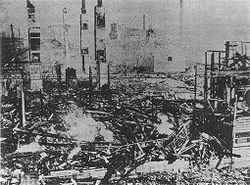1918年米騷動
| 本條目需要翻譯,請以改善其內容。 |
1918年米騷動(米騒動),亦被稱為米暴動,1918年7月至9月於日本發生的一系列騷動,導致了當時由寺內正毅領導政府的垮臺。

起因[編輯]
大米價格的暴漲造成了嚴重的經濟困難,對於以大米為主食的農村地區衝擊尤為嚴重。由於當時政府法定收購價與居高不下的時常價格之間的巨大差距,農民對於那些讓大米價格失控的米商和政府官員產生了極大的敵意。在第一次世界大戰後,米價達到了峰值。由此引發的通貨膨脹造成大量消費品和房租價格飆升,結果令城市居民也出現不滿情緒。 However, the Siberian Intervention further inflamed the situation, with the government buying up existing rice stocks to support the troops overseas, which further drove rice prices higher. The government failed to intervene in economic affairs, and rural protests spread to the towns and cities.
暴亂[編輯]
The Rice Riots were unparalleled in modern Japanese history in terms of scope, size and violence. The initial protest occurred in the small fishing town of Ouzu, Toyama Prefecture, on 23 July 1918.運動開始時只是和平的請願,但事態很快升級為暴亂、罷工、搶劫、蓄意炸毀警察局和政府辦公室以及武裝衝突。1918年9月中旬,在38座城市,153個鄉鎮以及177個村中出現了超過623起騷亂,參與者逾200萬人。約有25000人被逮捕,其中8200人被以不同的罪名判刑,輕則罰款,重則判處死刑。 [1]
由於對騷亂發生負有責任,首相Terauchi及其內閣成員於1918年9月29日辭職。
這次事件同日本軍國主義之間的聯繫尚無定論。學者爭論認為,為了減輕當時日本本土當時大米的供應緊張狀況,日本加強了在其當時的殖民地朝鮮和臺灣的大米生產。 [2]
參考書系[編輯]
- 比斯利, W.G. 《日本帝國主義1894~1945》(Japanese Imperialism 1894–1945). 牛津大學出版社(Oxford University Press). 1991. ISBN 0198221681.
- 麥克弗森, WJ. 《1868~1941:日本經濟發展》(The Economic Development of Japan 1868–1941). 劍橋大學出版社(Cambridge University Press). 1995. ISBN 0521557925.
- 史密特卡, 麥可. 《日本戰前經濟發展》(1600~1960:日本經濟史)(Japanese Prewar Growth (Japanese Economic History 1600–1960)). 勞特利奇. 1998. ISBN 0815327056.